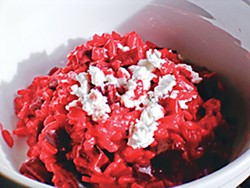[
{
"name": "Top Stories Video Pair",
"insertPoint": "7",
"component": "17087298",
"parentWrapperClass": "fdn-ads-inline-content-block",
"requiredCountToDisplay": "1"
}
]
Story and
Spirito di contraddizione was one of the epithets my mother would use in reference to me. I tend to do the opposite of what I am told. I refuse to buy red things and chocolates on Valentine's Day, but this year I spent the days leading to the celebration of the patron saint of lovers experimenting with red things (red beets, to be precise) and chocolate. Below, you will not read about how to surprise your significant other on Valentine's Day with culinary delights, for that day has passed. You will hear about how to have fun in the kitchen any day of the year — at least any day you can get hold of a bunch of fresh red beets. Such a bunch provides the main component and theme for three dishes, which may be served during the same meal: red beet risotto with chèvre, frittata with beet greens and chocolate-covered red beets.
At least one of the items listed above will probably sound strange. It sounded strange to me, too, when the idea formed in my mind to pair red beets with extra-dark chocolate. The rest of the menu developed from the dessert: The greens cut from the bunch make a great frittata and the root pieces left over from making choco-beets become the protagonists of a risotto. The final equation is: one bunch of red beets with their greens equals one colorful and flavorful trio of dishes to be served (with the accompaniment you like) any day of the year — except on Valentine's Day, if you follow my spirit of contradiction.
First prepare the sweet morsels. Preheat the oven to 375 degrees F. Carefully scrub the beets and remove the inedible parts at the top and bottom. If the beet is small, cut it into quarters (without peeling it) or into other bite-size pieces. If the beet is larger, cut 3/8-1/2-inch-thick slices and set aside the first and last one for use in the near future. With small cookie cutters, carve out bite-size pieces from the other slices. I owe this great idea to my friend Christine, who was one of the early tasters of my choco-beets in their original free-form incarnation. Warning: Your cookie cutters may get deformed when pushed through the beet slices. I have used a leaf- and a heart-shaped cutter and the latter took a bit of a beating.
Place the beet pieces in a single layer in a baking pan lined with parchment paper, leaving 1/2 an inch of space between them. Roast the beets until they are easily pierced with a pointed blade — 35 to 40 minutes, depending on their thickness. The parchment paper prevents the formation of a dark layer on the side that touches the pan. Let the beets cool while you slowly melt some extra-dark sweetened chocolate (preferably 70-75 percent cocoa content) in a small pan over very low heat (to prevent scorching). The quantity of chocolate depends on the amount of beets to cover. Start with 3 ounces of chocolate and melt more as needed. The beet pieces shaped by cookie cutters should be skinless. If you have free-form morsels, you may peel them before covering them with chocolate.
We are all familiar with chocolate-covered strawberries. Their stem provides a convenient handle that facilitates the dipping process. The beet pieces do not have any such handle, so use a toothpick to hold each piece while immersing it in the chocolate bath. After the piece emerges let the excess chocolate drip for a few seconds before depositing the choco-beet on a tray lined with wax paper. The toothpick leaves an unattractive hole to be sealed with a chocolate drop. Repeat the process with all the beet pieces and let them rest in a cool place until the chocolate has hardened.
Had you been making cookies, you would knead the scraps and obtain more dough to imprint with cookie cutters. Beets are not made of workable dough, so the plan for leftover use is to make risotto. Dice the remaining beets into pieces 1/2 inch pieces or so (their shape will be irregular and dependent on the shape of the cutter that generated them) until you have 8 oz. Spread on the parchment paper-lined baking pan and roast at 350 degrees F for 20 minutes.
A few months ago I wrote about making risotto with summer squash ("Table Talk," June 14, 2007). For this version, mince a medium shallot. After five minutes of delicate cooking in half a tablespoon of olive oil, add the roasted red beets (not the chocolate-covered ones). Let the beets familiarize themselves with the shallot for five minutes, adding a tablespoon or two of the already simmering vegetable broth (3 and 1/4 cups) when the saucepan becomes dry.
Add a cup of Arborio rice to the beets and let it toast for one minute, then add a tablespoon of balsamic vinegar and stir for another minute. The acidity of the vinegar brightens the vibrant color of the beets, which is due to a pigment called betacyanin. Start adding the broth, one ladleful at a time, until the rice is cooked al dente — 15 minutes. The rice should be soft and creamy, but with some body. If it feels a bit hard at the core, cook it a minute longer. Cut a quarter of a five ounce disk of Cypress Grove Chèvre, crumble it and add it directly to the risotto, turn off the heat, mix vigorously and let rest for a few minutes while you gather the guests around the table. Adjust the salt. Crumble more chèvre and sprinkle some over each portion of risotto before offering it to the prospective eater. The snow-white cheese provides a nice contrast to the red risotto.
I will save instructions on making the beet green frittata for another day. We will note today that it adds yellow and dark green to the meal palette. Finally, the choco-beets bring a look of surprise on everyone's face.
Several tasters have commented that the texture of the beet core reminded them of firm gelatin candies. The modestly sweet flavor of the beet pairs well with that of the bittersweet chocolate surrounding it. The latter provides the aftertaste. All the people who have tasted my choco-beets have asked for additional helpings, a sign of success.
If some of the choco-beets make it to the following day, you may notice tiny dark red drops on their surface, due to the beet natural sweating. In my experience, this has no negative impact on the flavor of the finished product. The choco-beets should be consumed within a day after they are made. Putting chocolate in the fridge is an act that breaks my heart, but if consumption is not complete within that time frame cold storage becomes necessary.
Some people have encouraged me to get other ideas along the same line of choco-beets, so you may hear more about chocolate-covered vegetables in the future. Parsnip, maybe?
Chocolate-Covered Red Beets
Ingredients:
one bunch fresh red beets
extra-dark sweetened chocolate
Preheat the oven to 375 F.
Line baking pan with parchment.
Cut beets into bite-size free-form pieces or into 3/8-1/2"-thick slices shaped with cookie cutters into bite-size pieces.
Place beet pieces in single layer in baking pan, leaving 1/2" space between them.
Roast beets 35 to 40 minutes, until they are easily pierced with a pointed blade.
Remove pan from oven.
Melt chocolate slowly in small pan over very low heat.
Use toothpick to hold beet pieces while immersing them in chocolate bath.
Let excess chocolate drip before putting choco-beet on wax paper lined tray.
Seal toothpick holes with chocolate drops.
Repeat process with all beet pieces and let them rest in a cool place until chocolate has hardened.
Eat within a day.
Red Beet Risotto with Chèvre
Ingredients:
8 oz. red beets (leftover from the previous recipe or whole)
3 and 1/4 cup vegetable broth
1/2-1 tablespoon olive oil
1 medium shallot, minced
1 cup Arborio rice
1 tablespoon balsamic vinegar
1 5-oz disk of Cypress Grove Chevre
Salt, to taste
Dice beets into 1/2" pieces.
Spread on parchment-lined baking pan and roast for 20 minutes at 350 F.
Bring broth to a simmer in 1-quart saucepan.
Warm oil in 2-quart saucepan, add shallot, cook over low heat for 5 minutes, stirring often.
Add beets, stir and cook for 5 minutes, adding simmering broth when the saucepan becomes dry.
Add rice and let it toast for one minute, then add vinegar and stir for another minute over medium-low heat.
Start adding broth, one ladleful at a time, until rice is cooked al dente - about 15 minutes.
Make sure rice never becomes dry and is always simmering.
If rice feels a bit hard at the core, cook for a minute longer.
Crumble Cypress Grove Chevre and add it to the risotto, turn off heat, mix vigorously and let rest for a few minutes.
Adjust the salt.
Crumble more chèvre and sprinkle some over each portion of risotto.
Serve, and eat, immediately.
Speaking of Food
more from the author
-
Spreading Vegetable Joy
Beets for a colorful vegan starter
- Jan 18, 2024
-
A Daily Dose of Awe
- Jan 4, 2024
-
Classic Oatmeal Cookies Revisited
- Dec 28, 2023
- More »



































